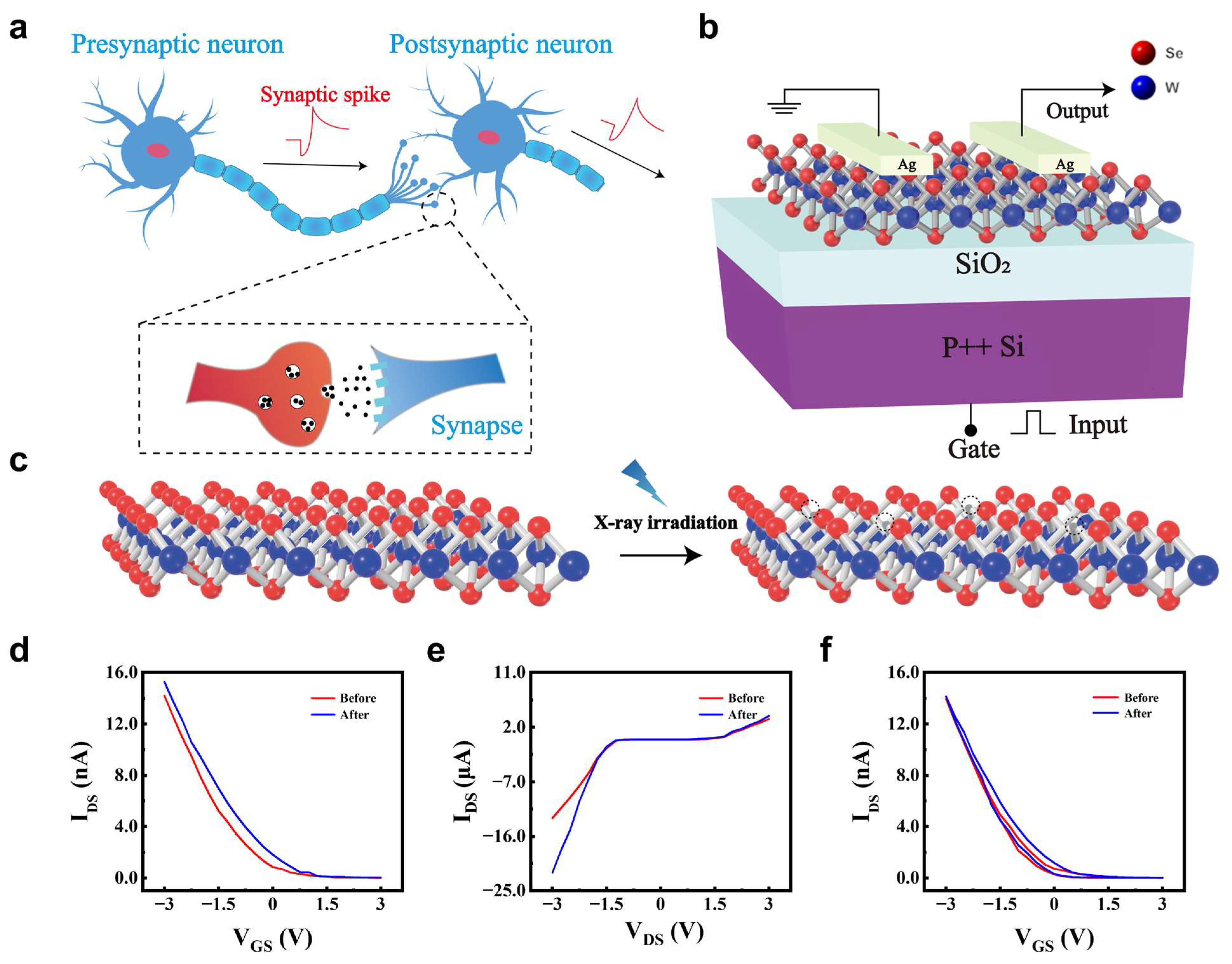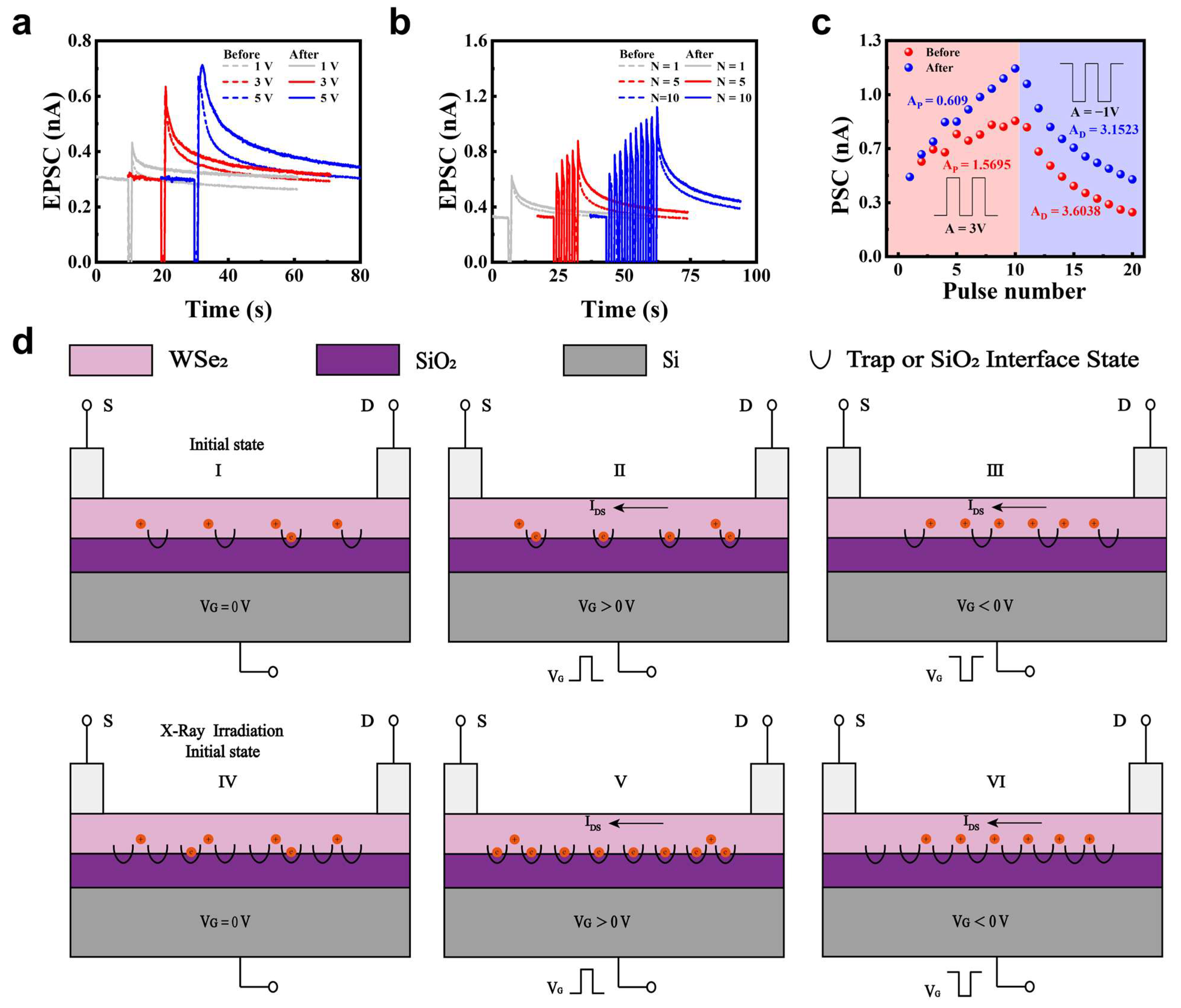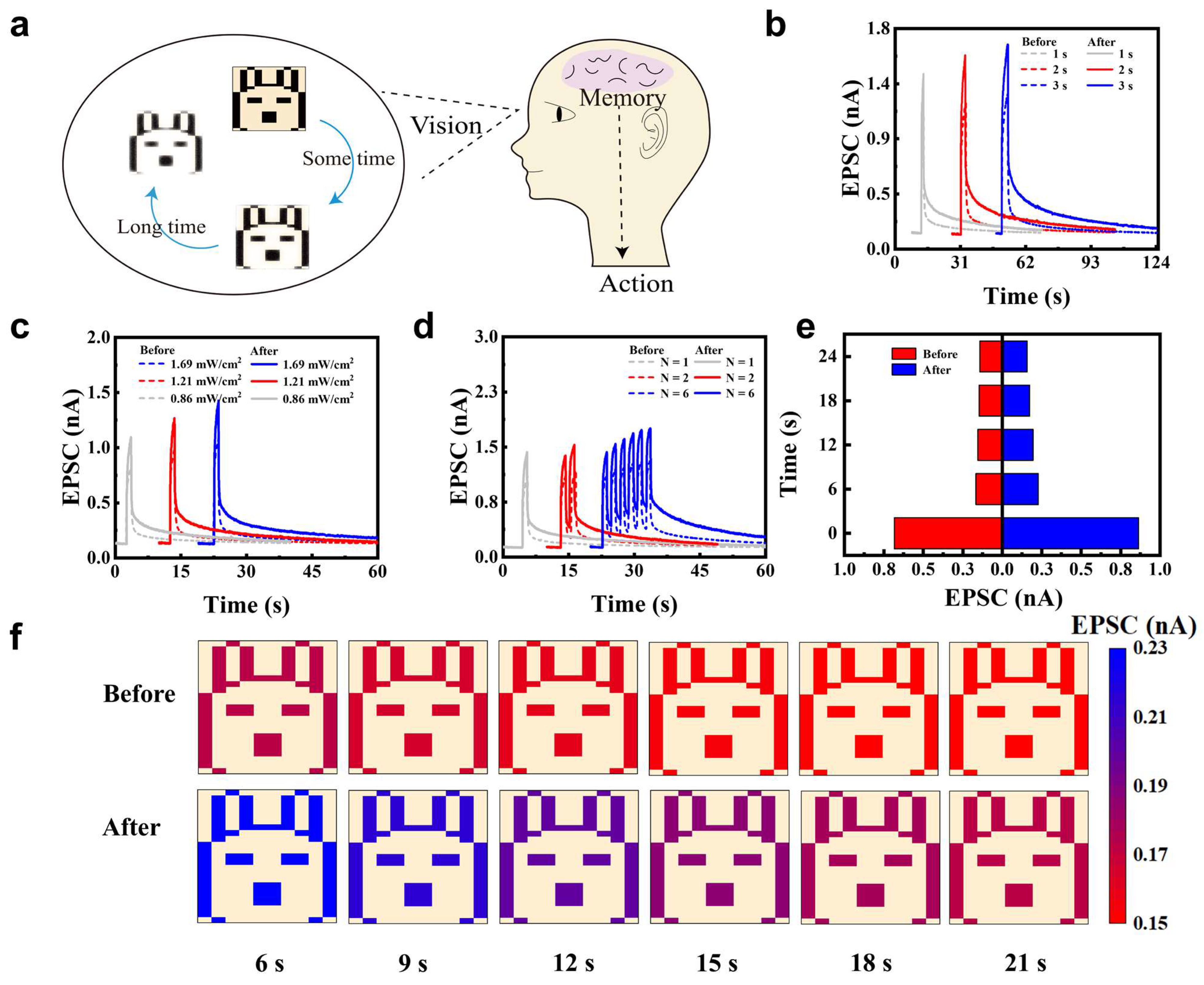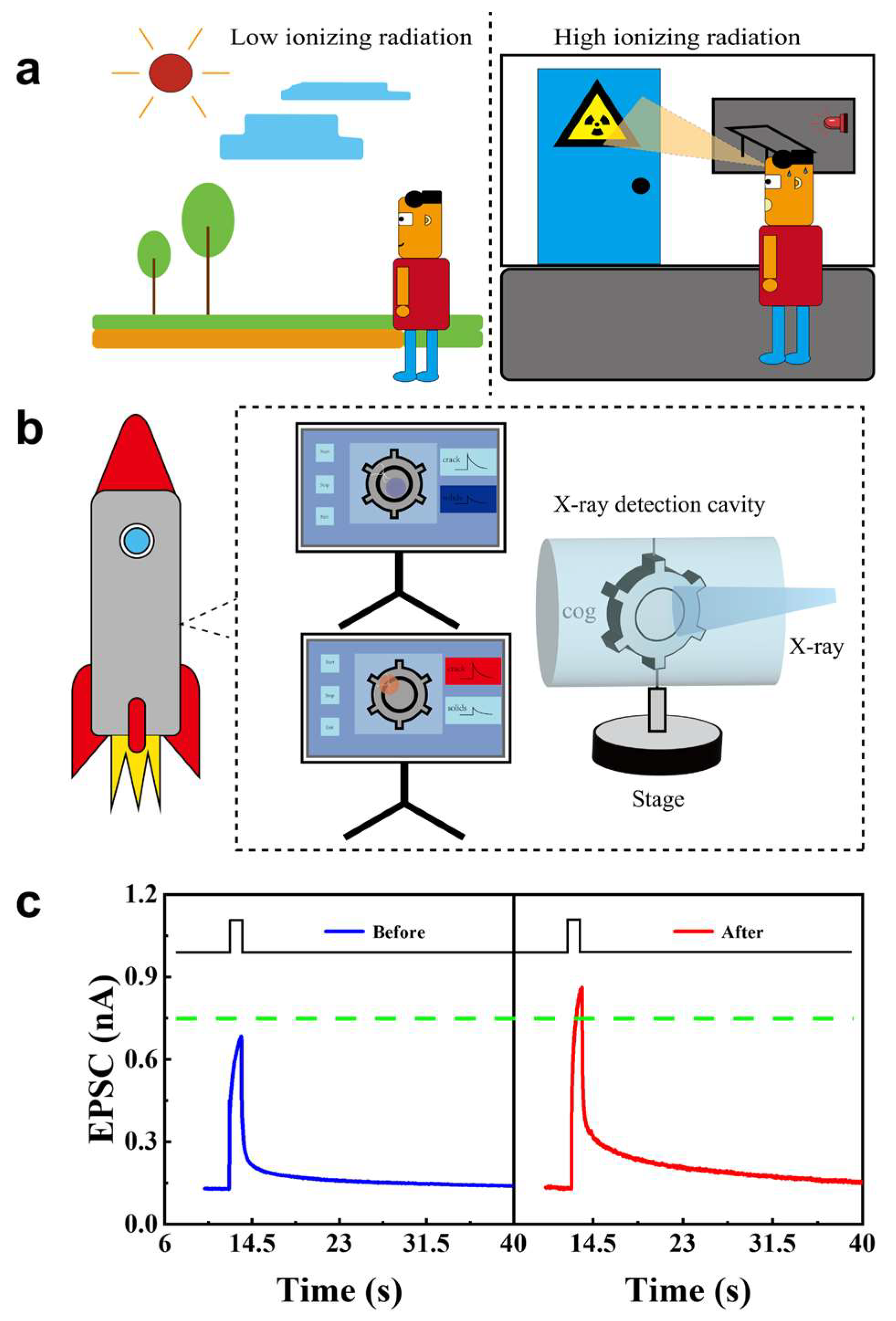X-Ray Irradiation Improved WSe2 Optical–Electrical Synapse for Handwritten Digit Recognition
Abstract
1. Introduction
2. Materials and Methods
2.1. WSe2 Synthesis
2.2. Device Fabrication
2.3. Morphology and Optical Characterization
2.4. Neural Network Simulation
3. Results and Discussion
4. Conclusions
Supplementary Materials
Author Contributions
Funding
Data Availability Statement
Conflicts of Interest
References
- Liang, Y.; Li, H.; Tang, H.; Zhang, C.; Men, D.; Mayer, D. Bioinspired Electrolyte-Gated Organic Synaptic Transistors: From Fundamental Requirements to Applications. Nano-Micro Lett. 2025, 17, 198. [Google Scholar] [CrossRef]
- Ning, H.; Yu, Z.; Zhang, Q.; Wen, H.; Gao, B.; Mao, Y.; Li, Y.; Zhou, Y.; Zhou, Y.; Chen, J.; et al. An in-memory computing architecture based on a duplex two-dimensional material structure for in situ machine learning. Nat. Nanotechnol. 2023, 18, 493–500. [Google Scholar] [CrossRef]
- Wang, S.; Sun, Z. Dual in-memory computing of matrix-vector multiplication for accelerating neural networks. Device 2024, 2, 100546. [Google Scholar] [CrossRef]
- Dang, B.; Zhang, T.; Wu, X.; Liu, K.; Huang, R.; Yang, Y. Reconfigurable in-sensor processing based on a multi-phototransistor–one-memristor array. Nat. Electron. 2024, 7, 991–1003. [Google Scholar] [CrossRef]
- Yao, P.; Wu, H.; Gao, B.; Tang, J.; Zhang, Q.; Zhang, W.; Yang, J.J.; Qian, H. Fully hardware-implemented memristor convolutional neural network. Nature 2020, 577, 641–646. [Google Scholar] [CrossRef]
- Jin, T.; Lv, K.; Chen, J.; Zhang, L.; Guo, X. Fully hardware-implemented neuromorphic systems using TaO -based memristors. Device 2025, 3, 100645. [Google Scholar] [CrossRef]
- Pazos, S.; Zhu, K.; Villena, M.A.; Alharbi, O.; Zheng, W.; Shen, Y.; Yuan, Y.; Ping, Y.; Lanza, M. Synaptic and neural behaviours in a standard silicon transistor. Nature 2025, 640, 69–76. [Google Scholar] [CrossRef]
- Yang, R.; Tian, Y.; Hu, L.; Li, S.; Wang, F.; Hu, D.; Chen, Q.; Pi, X.; Lu, J.; Zhuge, F.; et al. Dual-input optoelectronic synaptic transistor based on amorphous ZnAlSnO for multi-target neuromorphic simulation. Mater. Today Nano 2024, 26, 100480. [Google Scholar] [CrossRef]
- Xiao, Y.; Liu, Y.; Zhang, B.; Chen, P.; Zhu, H.; He, E.; Zhao, J.; Huo, W.; Jin, X.; Zhang, X.; et al. Bio-plausible reconfigurable spiking neuron for neuromorphic computing. Sci. Adv. 2025, 11, eadr6733. [Google Scholar] [CrossRef] [PubMed]
- Zou, L.R.; Lyu, X.D.; Sang, D.D.; Yao, Y.; Ge, S.H.; Wang, X.T.; Zhou, C.D.; Fu, H.L.; Xi, H.Z.; Fan, J.C.; et al. Two-dimensional MoS2/diamond based heterojunctions for excellent optoelectronic devices: Current situation and new perspectives. Rare Met. 2023, 42, 3201–3211. [Google Scholar] [CrossRef]
- Liu, C.; Jin, J.C.; Xiao, Y.K.; Wang, X.X.; Yan, P.Y.; Cao, Y.Q.; Jiang, L.Y.; Sheng, C.X.; Yu, Y.F. Graphene oxide/Al2O3-based diffusive memristor cells: Enabling robust crossbar arrays for multidisciplinary applications. Rare Met. 2024, 43, 3997–4005. [Google Scholar] [CrossRef]
- Su, Z.; Yan, Y.; Sun, M.; Xuan, Z.; Cheng, H.; Luo, D.; Gao, Z.; Yu, H.; Zhang, H.; Zuo, C.; et al. Broadband Artificial Tetrachromatic Synaptic Devices Composed of 2D/3D Integrated WSe2-GaN-based Dual-Channel Floating Gate Transistors. Adv. Funct. Mater. 2024, 34, 2316802. [Google Scholar] [CrossRef]
- Ma, M.; Huang, C.; Yang, M.; He, D.; Pei, Y.; Kang, Y.; Li, W.; Lei, C.; Xiao, X. Ultra-Low Power Consumption Artificial Photoelectric Synapses Based on Lewis Acid Doped WSe2 for Neuromorphic Computing. Small 2024, 20, 2406402. [Google Scholar] [CrossRef]
- Ding, G.; Yang, B.; Chen, R.S.; Mo, W.A.; Zhou, K.; Liu, Y.; Shang, G.; Zhai, Y.; Han, S.T.; Zhou, Y. Reconfigurable 2D WSe2-Based Memtransistor for Mimicking Homosynaptic and Heterosynaptic Plasticity. Small 2021, 17, 2103175. [Google Scholar] [CrossRef]
- He, Y.L.; Yan, J.H.; Yang, Y.T.; Lu, Y.X.; Liu, N.; Chen, P.; Liu, X.F.; Qiu, J.R.; Xu, B.B. Achieving enhanced linear and nonlinear optical absorption in a (PEA)2PbI4/WS2 heterojunction by efficient energy transfer. Rare Met. 2025, 44, 5877–5885. [Google Scholar] [CrossRef]
- Peng, Z.; Tong, L.; Shi, W.; Xu, L.; Huang, X.; Li, Z.; Yu, X.; Meng, X.; He, X.; Lv, S.; et al. Multifunctional human visual pathway-replicated hardware based on 2D materials. Nat. Commun. 2024, 15, 8650. [Google Scholar] [CrossRef] [PubMed]
- Dang, Z.; Guo, F.; Wang, Z.; Jie, W.; Jin, K.; Chai, Y.; Hao, J. Object Motion Detection Enabled by Reconfigurable Neuromorphic Vision Sensor under Ferroelectric Modulation. ACS Nano 2024, 18, 27727–27737. [Google Scholar] [CrossRef] [PubMed]
- Guo, Z.; Liu, J.; Han, X.; Ma, F.; Rong, D.; Du, J.; Yang, Y.; Wang, T.; Li, G.; Huang, Y.; et al. High-Performance Artificial Synapse Based on CVD-Grown WSe2 Flakes with Intrinsic Defects. ACS Appl. Mater. Interfaces 2023, 15, 19152–19162. [Google Scholar] [CrossRef] [PubMed]
- Yao, C.; Wu, G.; Huang, M.; Wang, W.; Zhang, C.; Wu, J.; Liu, H.; Zheng, B.; Yi, J.; Zhu, C.; et al. Artificial Synapse Based on Ambipolar Floating Gate Memory. ACS Appl. Mater. Interfaces 2023, 15, 23573–23582. [Google Scholar] [CrossRef] [PubMed]
- Chen, Q.; Wei, Y.; Zhai, P.-B.; Gong, Y.-J. Van der Waals gap engineering in 2D materials for energy storage and conversion. Rare Met. 2024, 43, 6125–6143. [Google Scholar] [CrossRef]
- Gao, Z.; Ju, X.; Zhang, H.; Liu, X.; Chen, H.; Li, W.; Zhang, H.; Liang, L.; Cao, H. InP Quantum Dots Tailored Oxide Thin Film Phototransistor for Bioinspired Visual Adaptation. Adv. Funct. Mater. 2023, 33, 2305959. [Google Scholar] [CrossRef]
- Wang, Q.; Wang, Y.; Wang, Y.; Jiang, L.; Zhao, J.; Song, Z.; Bi, J.; Zhao, L.; Jiang, Z.; Schwarzkopf, J.; et al. Long-term and short-term plasticity independently mimicked in highly reliable Ru-doped Ge2Sb2Te5 electronic synapses. InfoMat 2024, 6, e12543. [Google Scholar] [CrossRef]
- Lan, H.Y.; Lin, C.P.; Liu, L.; Cai, J.; Sun, Z.; Wu, P.; Tan, Y.; Yang, S.H.; Hou, T.H.; Appenzeller, J.; et al. Uncovering the doping mechanism of nitric oxide in high-performance P-type WSe2 transistors. Nat. Commun. 2025, 16, 4160. [Google Scholar] [CrossRef] [PubMed]
- Lin, Y.; Chang, Y.; Chen, K.; Lee, T.; Hsiao, B.; Tsai, T.; Yang, Y.; Lin, K.; Suenaga, K.; Chen, C.; et al. Patterning and doping of transition metals in tungsten dichalcogenides. Nanoscale 2022, 14, 16968–16977. [Google Scholar] [CrossRef]
- Hu, Y.; Lin, Y.; Zhang, X.; Zhao, Y.; Li, L.; Zhang, Y.; Lei, H.; Pan, Y. Optoelectronic synapses realized on large-scale continuous MoSe2 with Te doping induced tunable memory functions. Nanoscale Horiz. 2025, 10, 1354–1364. [Google Scholar] [CrossRef] [PubMed]
- Tan, Y.; Yang, S.H.; Lin, C.P.; Vega, F.J.; Cai, J.; Lan, H.Y.; Tripathi, R.; Sharma, S.; Shang, Z.; Hou, T.H.; et al. Monolayer WSe2 Field-Effect Transistor Performance Enhancement by Atomic Defect Engineering and Passivation. ACS Nano 2025, 19, 8916–8925. [Google Scholar] [CrossRef] [PubMed]
- Cui, Y.H.; Ouyang, W.C.; Gao, A.J.; Yu, C.Y.; Zhang, L.P. Promoting electrocatalytic nitrogen reduction to ammonia via dopant boron on two-dimensional materials. Rare Met. 2024, 43, 5117–5125. [Google Scholar] [CrossRef]
- Chaudhary, M.; Yang, T.Y.; Chen, C.T.; Lai, P.C.; Hsu, Y.C.; Peng, Y.R.; Kumar, A.; Lee, C.H.; Chueh, Y.L. Emulating Neuromorphic and In-Memory Computing Utilizing Defect Engineering in 2D-Layered WSeOX and WSe2 Thin Films by Plasma-Assisted Selenization Process. Adv. Funct. Mater. 2023, 33, 2303697. [Google Scholar] [CrossRef]
- Wu, X.; Gu, Y.; Ge, R.; Serna, M.I.; Huang, Y.; Lee, J.C.; Akinwande, D. Electron irradiation-induced defects for reliability improvement in monolayer MoS2-based conductive-point memory devices. npj 2D Mater. Appl. 2022, 6, 31. [Google Scholar] [CrossRef]
- Varshney, K.; Shukla, P.; Prakash, B.; Das, D.M.; Rawat, B. Enhancing Resistive Switching Characteristics of MoS2-based Memristor through O2 Plasma Irradiation-Induced Defects. IEEE J. Electron Devices Soc. 2024, 13, 737–744. [Google Scholar] [CrossRef]
- Pei, J.; Song, A.; Chen, J.; Jin, W.; Yang, F.; Zhao, H.; Ma, T. Tuning properties of graphene by oxygen plasma treatment-induced defect engineering. Sci. China Mater. 2024, 67, 2023–2031. [Google Scholar] [CrossRef]
- Oh, S.; Jung, S.; Ali, M.H.; Kim, J.H.; Kim, H.; Park, J.H. Highly Stable Artificial Synapse Consisting of Low-Surface Defect van der Waals and Self-Assembled Materials. ACS Appl. Mater. Interfaces 2020, 12, 38299–38305. [Google Scholar] [CrossRef]
- Liu, C.; Pan, J.; Yuan, Q.; Zhu, C.; Liu, J.; Ge, F.; Zhu, J.; Xie, H.; Zhou, D.; Zhang, Z.; et al. Highly Reliable Van Der Waals Memory Boosted by a Single 2D Charge Trap Medium. Adv. Mater. 2024, 36, 2305580. [Google Scholar] [CrossRef] [PubMed]
- He, S.; Cao, S.; Liu, Y.; Chen, W.; Lyu, P.; Li, W.; Bao, J.; Sun, W.; Kan, C.; Jiang, M.; et al. Giant Photoluminescence Enhancement of Ga-Doped ZnO Microwires by X-Ray Irradiation. Adv. Sci. 2025, 12, 2407144. [Google Scholar] [CrossRef] [PubMed]
- Guo, K.; Song, J.; Li, W.; He, Y.; Yang, B.; Wei, H. Water-Stable and Sensitive X-ray Detectors by Supramolecular Interaction-Enhanced Polyoxometalates. J. Am. Chem. Soc. 2024, 146, 26207–26215. [Google Scholar] [CrossRef]
- Lei, Y.; Xu, L.; Wang, Y.; Lian, L.; Liu, C.; Wang, Y.; Liang, L.; Qin, Z.; Han, S.; Zheng, W.; et al. A highly efficient Na-doped Cs3Cu2I5 scintillator for γ-ray detection and flexible X-ray imaging. J. Mater. Chem. A 2025, 13, 22660–22671. [Google Scholar] [CrossRef]
- Zhang, H.; Deng, Z.; Jiang, H.; Wang, S.; Wei, J.; Ge, Y.; Chu, G.; Chen, X.; Wang, H.; Yan, Y.; et al. High-brightness betatron X-ray source driven by the SULF-1 PW laser. High Power Laser Sci. Eng. 2025, 13, e31. [Google Scholar] [CrossRef]
- Choi, S.; Oh, G.H.; Kim, T.; Hong, S.; Kim, A. Radiation induced changes in chemical and electronic properties of few-layer MoS2 and MoTe2 films. Appl. Surf. Sci. 2024, 652, 159282. [Google Scholar] [CrossRef]
- Kolhe, P.T.; Dalvi, S.N.; Hase, Y.V.; Jadhav, P.R.; Ghemud, V.S.; Jadkar, S.R.; Dhole, S.D.; Dahiwale, S.S. Effect of gamma-ray irradiation on structural and optical property of WSe2 film. J. Mater. Sci. Mater. Electron. 2023, 34, 1704. [Google Scholar] [CrossRef]
- Dong, B.B.; Zhou, L.; Wang, X.T.; Xu, F.X.; Wang, D.J.; Shen, E.W.; Cai, X.Y.; Wang, Y.; Wang, N.; Ji, S.-J.; et al. cAMP−EPAC−PKCε−RIM1α signaling regulates presynaptic long-term potentiation and motor learning. eLife 2023, 12, e80875. [Google Scholar] [CrossRef]
- Zhou, Y.; Wang, Y.; Zhuge, F.; Guo, J.; Ma, S.; Wang, J.; Tang, Z.; Li, Y.; Miao, X.; He, Y.; et al. A Reconfigurable Two-WSe2-Transistor Synaptic Cell for Reinforcement Learning. Adv. Mater. 2022, 34, 2107754. [Google Scholar] [CrossRef] [PubMed]
- Zhang, X.; Ao, Z.; Lan, X.; Li, W. Photodetector based on 2H-WSe2 grown by physical vapor deposition method. Mater. Lett. 2024, 367, 136580. [Google Scholar] [CrossRef]
- Jin, M.; Zheng, W.; Ding, Y.; Zhu, Y.; Wang, W.; Huang, F. Raman Tensor of WSe2 via Angle-Resolved Polarized Raman Spectroscopy. J. Phys. Chem. C 2019, 123, 29337–29342. [Google Scholar] [CrossRef]
- Li, Z.; Wang, Y.; Jiang, J.; Liang, Y.; Zhong, B.; Zhang, H.; Yu, K.; Kan, G.; Zou, M. Temperature-dependent Raman spectroscopy studies of 1–5-layer WSe2. Nano Res. 2020, 13, 591–595. [Google Scholar] [CrossRef]
- Schwarz, A.; Alon-Yehezkel, H.; Levi, A.; Yadav, R.K.; Majhi, K.; Tzuriel, Y.; Hoang, L.; Bailey, C.S.; Brumme, T.; Mannix, A.J.; et al. Thiol-based defect healing of WSe2 and WS2. npj 2D Mater. Appl. 2023, 7, 59. [Google Scholar] [CrossRef]
- Wu, X.; Zheng, X.; Zhang, G.; Chen, X.; Dong, H. γ-Ray irradiation-induced unprecedent optical, frictional and electrostatic performances on CVD-prepared monolayer WSe2. Rsc Adv. 2021, 11, 22088–22094. [Google Scholar] [CrossRef]
- Bandyopadhyay, A.S.; Biswas, C.; Kaul, A.B. Light-matter interactions in two-dimensional layered WSe2 for gauging evolution of phonon dynamics. Beilstein J. Nanotechnol. 2020, 11, 782–797. [Google Scholar] [CrossRef] [PubMed]
- Ko, S.; Shin, J.; Jang, J.; Woo, J.; Kim, J.; Park, J.; Yoo, J.; Zhou, C.; Cho, K.; Lee, T. Reduced interface effect of proton beam irradiation on the electrical properties of WSe2/hBN field effect transistors. Nanotechnology 2024, 35, 305201. [Google Scholar] [CrossRef]
- Sun, X.; Yin, S.; Wei, D.; Li, Y.; Ma, Y.; Dai, X. Effect of vacancies on photogalvanic effect in two-dimensional WSe2 photodetector. Appl. Surf. Sci. 2023, 610, 155401. [Google Scholar] [CrossRef]
- Wang, M.; Lv, Y.; Li, S.; Zhao, J.; Cao, D.; Luo, G.; Jiang, Y.; Song, X.; Yan, Y.; Xia, C. Memory Window Ratio Enhancement of p-Type WSe2 Memtransistors Using Dielectric GeSe2 Nanosheets with Asymmetric Interfaces for Neuromorphic Computing. ACS Appl. Nano Mater. 2023, 6, 15632–15640. [Google Scholar] [CrossRef]
- Knobloch, T.; Uzlu, B.; Illarionov, Y.Y.; Wang, Z.; Otto, M.; Filipovic, L.; Waltl, M.; Neumaier, D.; Lemme, M.C.; Grasser, T. Improving stability in two-dimensional transistors with amorphous gate oxides by Fermi-level tuning. Nat. Electron. 2022, 5, 356–366. [Google Scholar] [CrossRef]
- Kumbhakar, P.; Jayan, J.S.; Sreedevi Madhavikutty, A.; Sreeram, P.R.; Saritha, A.; Ito, T.; Tiwary, C.S. Prospective applications of two-dimensional materials beyond laboratory frontiers: A review. iScience 2023, 26, 106671. [Google Scholar] [CrossRef]
- Wang, X.; Chen, F.; Li, X.; Xiang, T.; Wang, L. Emulation of Optoelectronic Synaptic Behavior in a MoS2/WSe2-Based p–n van der Waals Heterostructure Memtransistor. ACS Appl. Electron. Mater. 2024, 6, 4311–4320. [Google Scholar] [CrossRef]
- Lin, K.-Q.; Faria Junior, P.E.; Hübner, R.; Ziegler, J.D.; Bauer, J.M.; Buchner, F.; Florian, M.; Hofmann, F.; Watanabe, K.; Taniguchi, T.; et al. Ultraviolet interlayer excitons in bilayer WSe2. Nat. Nanotechnol. 2023, 19, 196–201. [Google Scholar] [CrossRef]
- Peng, X.; Huang, S.; Jiang, H.; Lu, A.; Yu, S. DNN+NeuroSim V2.0: An End-to-End Benchmarking Framework for Compute-in-Memory Accelerators for On-Chip Training. IEEE Trans. Comput.-Aided Des. Integr. Circuits Syst. 2021, 40, 2306–2319. [Google Scholar] [CrossRef]
- Jo, S.H.; Chang, T.; Ebong, I.; Bhadviya, B.B.; Mazumder, P.; Lu, W. Nanoscale Memristor Device as Synapse in Neuromorphic Systems. Nano Lett. 2010, 10, 1297–1301. [Google Scholar] [CrossRef]
- Sonoda, T.; Stephany, C.; Kelley, K.; Kang, D.; Wu, R.; Uzgare, M.; Fagiolini, M.; Greenberg, M.; Chen, C. Experience influences the refinement of feature selectivity in the mouse primary visual thalamus. Neuron 2025, 113, 1352–1362. [Google Scholar] [CrossRef] [PubMed]
- Jeong, B.H.; Lee, J.; Ku, M.; Lee, J.; Kim, D.; Ham, S.; Lee, K.-T.; Kim, Y.-B.; Park, H.J. RGB Color-Discriminable Photonic Synapse for Neuromorphic Vision System. Nano-Micro Lett. 2025, 17, 78. [Google Scholar] [CrossRef]
- Shao, H.; Li, Y.; Zhuang, J.; Ji, Y.; He, X.; Wang, R.; Wang, L.; Fu, J.; Li, W.; Yi, M.; et al. Retinomorphic Photonic Synapses for Mimicking Ultraviolet Radiation Sensing and Damage Imaging. Adv. Funct. Mater. 2024, 34, 2316381. [Google Scholar] [CrossRef]
- Thoreson, W.B.; Zenisek, D. Presynaptic Proteins and Their Roles in Visual Processing by the Retina. Annu. Rev. Vis. Sci. 2024, 10, 347–375. [Google Scholar] [CrossRef] [PubMed]
- Xiao, T.P.; Feinberg, B. On the accuracy of analog neural network inference accelerators. IEEE Circuits Syst. Mag. 2022, 22, 26–48. [Google Scholar] [CrossRef]
- Spear, M.; Kim, J.E.; Bennett, C.H.; Agarwal, S.; Marinella, M.J.; Xiao, T.P. The Impact of Analog-to-Digital Converter Architecture and Variability on Analog Neural Network Accuracy. IEEE J. Explor. Solid-State Comput. Devices Circuits 2023, 69, 1480–1493. [Google Scholar] [CrossRef]
- Wu, Z.; Li, Z.; Lin, X.; Shan, X.; Chen, G.; Yang, C.; Zhao, X.; Sun, Z.; Hu, K.; Wang, F.; et al. Diverse long-term potentiation and depression based on multilevel LiSiOx memristor for neuromorphic computing. Nanotechnology 2023, 34, 475201. [Google Scholar] [CrossRef] [PubMed]





Disclaimer/Publisher’s Note: The statements, opinions and data contained in all publications are solely those of the individual author(s) and contributor(s) and not of MDPI and/or the editor(s). MDPI and/or the editor(s) disclaim responsibility for any injury to people or property resulting from any ideas, methods, instructions or products referred to in the content. |
© 2025 by the authors. Licensee MDPI, Basel, Switzerland. This article is an open access article distributed under the terms and conditions of the Creative Commons Attribution (CC BY) license (https://creativecommons.org/licenses/by/4.0/).
Share and Cite
Chen, C.; Sun, Q.; Lu, Y.; Chen, P. X-Ray Irradiation Improved WSe2 Optical–Electrical Synapse for Handwritten Digit Recognition. Nanomaterials 2025, 15, 1408. https://doi.org/10.3390/nano15181408
Chen C, Sun Q, Lu Y, Chen P. X-Ray Irradiation Improved WSe2 Optical–Electrical Synapse for Handwritten Digit Recognition. Nanomaterials. 2025; 15(18):1408. https://doi.org/10.3390/nano15181408
Chicago/Turabian StyleChen, Chuanwen, Qi Sun, Yaxian Lu, and Ping Chen. 2025. "X-Ray Irradiation Improved WSe2 Optical–Electrical Synapse for Handwritten Digit Recognition" Nanomaterials 15, no. 18: 1408. https://doi.org/10.3390/nano15181408
APA StyleChen, C., Sun, Q., Lu, Y., & Chen, P. (2025). X-Ray Irradiation Improved WSe2 Optical–Electrical Synapse for Handwritten Digit Recognition. Nanomaterials, 15(18), 1408. https://doi.org/10.3390/nano15181408






